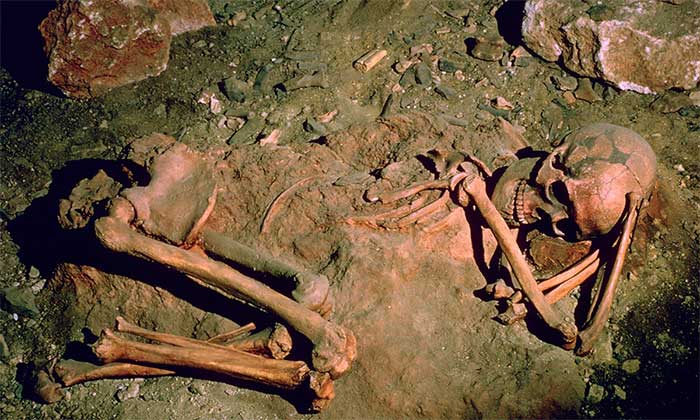The oldest known graves of modern humans (Homo sapiens), dating back 120,000 years, can be found in caves like Qafzeh Cave in Israel.
Many cultures around the world choose to honor the deceased through burial practices. The rituals accompanying this activity are deeply historical and traditional, varying from culture to culture. So, when did humans first begin to bury their dead?

An example of a Paleolithic grave in France. (Photo: CM Dixon/Print Collector/Getty).
There is no definitive answer to this question as not all graves have been preserved, let alone discovered and studied. However, the oldest evidence to date comes from the Middle Paleolithic (approximately 300,000 – 30,000 years ago).
At least 120,000 years ago, intentional burials were taking place, according to Mary Stiner, an anthropology professor at the University of Arizona. Stiner does not rule out the possibility of older graves existing but suggests that the most convincing ancient examples of modern humans (Homo sapiens) burying their dead come from the Middle Paleolithic. Some studies suggest that extinct relatives of humans buried their dead around 300,000 years ago, in what is now South Africa, but this remains a topic of debate.
The oldest graves of modern humans, dating back 120,000 years, are found in caves such as Qafzeh Cave in Israel. There is also evidence of Neanderthal graves in caves dating back 115,000 years, according to the Australian Museum. Stiner notes that humans extensively utilized caves during the Middle Paleolithic for purposes such as food consumption, living, and social interaction.
Many researchers, including Stiner, believe that these ancient graves were deliberate actions by humans, not the result of natural occurrences (such as cave collapses) since the bones were arranged in specific postures (for example, fetal positions) along with human artifacts. In some cases, there are even clear signs that older sediments were disturbed for burial.
Scientists do not fully understand the origins of burial practices, but ancient people had many reasons for handling corpses both inside and outside of caves. Humans and many animal species exhibit an “inherent aversion” to decomposition, according to Trish Biers, a manager at the Duckworth Laboratory of the Human Evolutionary Studies Center at the University of Cambridge.
Humans needed to find ways to deal with bodies as they began to decompose, emit odors, and attract flies, pathogens, and scavengers. Initially, burial or other forms of body disposal may have been aimed solely at addressing these practical issues, later evolving into more complex practices.
The evolution toward complex burial practices did not necessarily occur in a linear fashion. A study published in The Oxford Handbook of the Archaeology of Death and Burial (Oxford University Press, 2013) indicates that complex graves in Eurasia appeared and disappeared at the end of the Upper Paleolithic (45,000 – 10,000 years ago).
The authors of the study also noted that it is challenging to draw definitive conclusions about the nature and significance behind late Upper Paleolithic graves, as scientists have only found a limited number of such graves. Furthermore, ancient graves also vary by region.
According to Biers, the manner in which people buried their dead depends on various factors, including the environment and available materials. Cremation methods emerged much later, with the earliest recorded cremation grave named Mungo Lady in Australia, dating back approximately 40,000 years.


















































